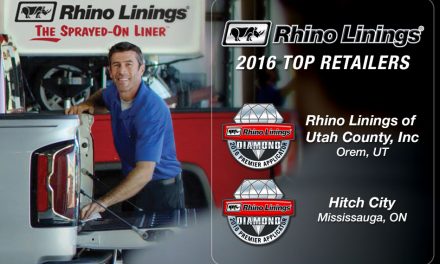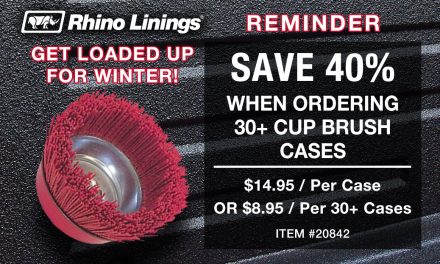For contractors new and experienced, finding optimal productivity in day-to-day work can be difficult to perfect.
Throughout my experience as an SPF contractor, I learned that controlling productivity in SPF application meant the difference between profits and loss. Whether you are just learning the ropes or you have set habits, there are a number of steps you can take to be more productive.
Make Productivity a Routine
Start with a clean and orderly spray rig. When everything is in its place and accessible, the amount of time searching for tools and supplies is decreased.
Create a step-by-step procedure to ensure the installation crew isn’t wasting precious time trying to figure out the next step in daily prep.
Replacing lost tools can be expensive and missing tools result in lost man hours the following day because required tools are not available. Appoint a responsible rig leader to ensure that everything is returned to the rig and everything is placed where it belongs every night. In addition, consider adding shadow walls or hanging boards in your spray rig that put an outline of tools where they belong to make this aspect of the job fast and thorough.
The rig leader should also be responsible for regular job tracking, equipment maintenance and should be required to complete appropriate job forms – both those that are left on the job site and those that must be returned to the office. The job forms completed by the rig leader should verify and document the regular maintenance and cleaning of equipment. Clean and well maintained equipment will spray correctly and evenly to reduce spray application issues. Check out last month’s technical article to learn more about the importance of job logs.
Protect Your Product and Equipment
Ensure that barrels are always kept at the proper temperature using band heaters or heated blankets. Neglecting to have the chemicals at the appropriate temperature as they enter the reactor can reduce yield because the delta T of the reactor may not be able to achieve the required temperature. Controlling chemical temperature will help maximize yield and reduce wear and tear on equipment while also reducing the amount of gun cleaning and maintenance required.
Account for the “Aesthetics vs Yield” Dilemma.
Aesthetics or yield…you can’t typically have both! When spraying SPF in an exposed cavity, productivity and yield can take a back seat to appearance. In an exposed cavity application, sprayers will spend more time prepping, applying and ensuring that the appearance meets expectations. It may be necessary for you to adjust the job quote to include some level of added surcharge for lost yield and required coatings.
To Optimize Aesthetics While Sacrificing the Least Yield:
Optimizing yield goes hand-in-hand with optimizing productivity because many of the techniques that increase yield also improve quality and reduced the time required to apply. For the best looking application begin spraying at a 45° angle in a 3-4’ long up and down motion to the left or right stud, build an appropriate level of material thickness and then ride the wave, or follow the dark line across the cavity. Move to an angle that is perpendicular to the substrate while maintaining an 80-90% overlap. Finish spraying at a 45° angle to the opposing stud.
When spraying in this manner with a formulation that is intended for wall application, the foam will begin to rise well in advance of your spray pattern coming back down the wall. Spraying into already rising foam will cause retardation of growth and will reduce yield through impingement and the triggering of the gun at the top and bottom of each stroke can cause wrist and hand fatigue, reducing the amount of time that an applicator can spray before breaking. These issues can’t typically be avoided while spraying with this technique but by using this method the finished aesthetics should be pleasing and the amount of coatings required should be somewhat reduced.
To Optimize Yield When Aesthetics Are Not Important:
For a maximum yield application where aesthetics are not priority, start by picture-framing the cavity (spray around the outside edges), then fill the field with a back and forth pattern starting from the top or bottom, laying in the appropriate amount of liquid to achieve the thickness that is desired in one pass. The operative phrase here is “one pass;” since spraying multiple passes creates knit lines. Knit lines are earmarked by the densified layer or skin that develops on the surface of the former pass. This skin is only a few mils thick but is representative of a solid plastic. Each knit line created within the total foam thickness will result in a loss of approximately 5% yield. Whether you are optimizing for aesthetics or yield, enhance productivity by avoiding impingement and knit lines.
Make Sustainable Changes
I know there is so much more that can go into improving productivity. These are just a few of the things that I found to be beneficial as a contractor. The most important thing with productivity is to make your change easy to adapt to. Start focusing on one item on this list, see how it impacts your daily output, and move forward from there.
Keep reading our newsletters to get more tips on how to build a successful spray foam contracting business. For more details on how to get started with Rhino Linings SPF products, call 877.358.1320 or visit spf.rhinolinings.com
About the Author
John Stephens is the Territory Sales Manager for the Western region and has more than 26 years of experience in the construction industry as a general contractor. John brings extensive knowledge in spray foam insulation, Graco® spray equipment and gun repair, plural component proportioners and related equipment, insulation codes, building science, as well as getting the most from your bid.





